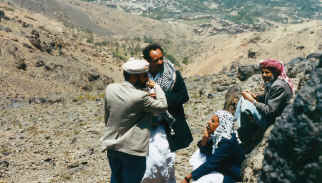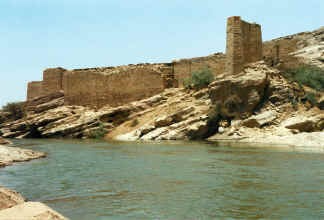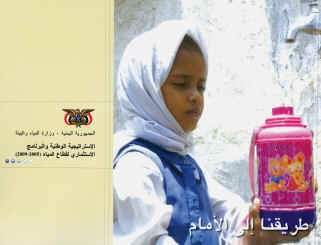Water in Yemen: Changing views on a changing natural resource
Jac van der Gun
The author is a water resources specialist who was closely involved in the water sector in Yemen during the 1980s and 1990s. Here he summarises his presentation at a joint meeting of the Society for Arabian Studies and the British-Yemeni Society on 20 May 2008.
Yemen: a water-scarce country
Yemen is a dry country. Those who have travelled there will recognise what Van der Meulen and Von Wissmann wrote in the introduction to their book
Hadramaut: Some of its mysteries unveiled (1932):
'... Bare precipitous rocks defy the most daring climber. How burning hot must be those shining cliff walls, where no shadows fall! Their dim, black colour looks cruel in this land of light and heat. At times too we see, when approaching the Arabian Peninsula, a grey plain or rigid sea of sand with high curved waves, motionless and silent. The air over that land quivers in the heat and makes everything look indistinct and hazy; the sky above is
colourless, like molten lead, torturing the eyes...'
This impression was certainly influenced by the authors' itinerary, starting at Mukalla and leading across the barren and monotonous jawl plateau towards Wadi Hadhramaut. It contrasts with their excitement later in the book as they descend into Wadi Do'an, one of Wadi Hadhramaut's tributaries:
'We see ... immediately at our feet glittering, yellow walls of rock, and then, down below in the depth, a marvel of colour and charm. The sun shines right into the wadi where no life or movement are to be seen. Between patches of gay yellowish green, formed by the fields of
dhura, maize and lucerne, lies unruffled the broad, shining grey-green strip of date-groves. Through it winds a snow-white ribbon, the sandy bed of the
sel ... Wadi Do'an lies there between its high rocky banks ... like a forgotten bit of paradise ... This is the reward of weary travellers in the desert. We are filled with joy.'
They were not the first nor the last travellers to have this kind of experience. The famous traveller Ibn Battutah, more familiar with dry climates than those two Europeans, visited Southern Arabia more than six centuries earlier. He mentions the presence of water-endowed zones amidst the generally barren areas which he crossed. He noted that 'Zabid lies amid luxuriant gardens, with many streams and fruits'; he describes Jibla as being 'a small and pretty town with palms, fruit trees and streams; and Sana'a as 'a large and well-constructed city, built with bricks and plaster, with many trees and fruits and with a temperate climate and good water. Aden, he adds, 'is a large city but has no crops, trees or water, and has reservoirs in which water is collected during the rainy season.'
These descriptions illustrate very well two dominant aspects of the physical environment of Yemen: large areas of barren rocks and desert, and scattered oasis-like locations or zones where water is relatively abundant. More recent systematic meteorological, hydrological and hydrogeological observations confirm this picture of a generally very dry country and help understanding how water availability varies in space and time (Van der Gun and Ahmed, 1995). Rainfall is seasonal and only the western and southern slopes of the Yemen Mountain Massif (less than 10% of the national territory) enjoy a mean annual total over 250 mm, including a few zones (less than 2% of the territory) where 500 mm/year is exceeded. Mean annual rainfall is less than 100 mm in more than half of the country. Combining rainfall with other climate data results in the qualification 'hyper-arid' for about two-thirds of the country's territory, 'arid' for more than a quarter and 'semi-arid or sub-humid' for the remainder. Occasionally there are surface water flows running through the wadis, but except for a few short flood events each year, the wadi beds remain dry or convey only a minor trickle of water, the so-called base flow.
 |
| |
 |
| |
Yemen – a dry country with variable water
resources. |
| |
 |
| |
| Southern sluice of the old Marib dam. |
Yemen thus can be called a dry country, but is it water-scarce as well? Scarcity of water would imply that its availability is less than desired to satisfy all wants and needs. This is certainly the case almost everywhere in Yemen, where lack of water severely limits agricultural development and endangers sustainable domestic water supply. 'Annual renewable blue water per capita' (blue water is surface water and groundwater combined) indicates the upper limit to the quantity of water per capita that can be sustainably captured to satisfy water demands not met by local rainfall. For Yemen around the year 2000 the value of this indicator is approximately 150 m3, which ranks Yemen among the 10% most water-scarce countries in the world (IGRAC, 2009). With a steadily increasing population, water-scarcity will become more severe year after year.
How have Yemenis traditionally coped with water scarcity?
Yemenis have lived with water scarcity since time immemorial. Their ability to adapt to natural conditions and to develop techniques to conserve and manage water resources have enabled them cope with the challenge. Adaptation to natural conditions is clearly reflected in the population density of the country's different regions. People have settled where water is more or less readily available. Hence, the great majority of Yemen's population live in or near the mountain massif region, where orographic conditions cause rainfall to be significantly higher than elsewhere in the country. The eastern two thirds of the country - including inland deserts (Ramlat as-Sabatayn and part of the Rub al-Khali), the wide canyon of Wadi Hadhramaut and the vast eastern plateaus - are sparsely populated.
It is no surprise that most towns and other major settlements are found at locations that are, or used to be, relatively richly endowed with water. Until a few decades ago, Sana'a enjoyed the presence of abundant shallow groundwater and nearby springs. Ta'izz, located at the foot of Mount Sabr, had good rainfall and numerous springs. Sa'dah, Amran, Dhamar, Ibb and several other small towns in the highlands developed on intramontane alluvial plains, overlying shallow groundwater. Outside urban centres, water availability is reflected in the selection of the agricultural crops which are grown.
In addition to adaptation, people have developed and applied techniques to make water available for all purposes, where and when it is needed. This 12 is testified by the numerous terraces on mountain slopes all over western Yemen; by many other water harvesting sites where surface runoff is concentrated; by cisterns spread over the country to collect and store runoff water; by the diversion of flows from wadis and springs; by qanats and numerous wells tapping groundwater; and by dams constructed across wadis to store or regulate the flow of water.
All these technical interventions have contributed very significantly to water supply and food production in a generally water-scarce environment. The
qanats (or 'ghayls') of Sana'a (Serjeant, Costa and Lewcock, 1983) and the ancient Marib dam (Schmidt, 1988), abandoned nowadays, are spectacular examples of hydraulic engineering in the remote past.
Islamic culture, tradition and law contribute positively to coping with water scarcity. They highlight the special status of water
(From water We created all living things, as the Holy Koran says), and consider water as common property, not as a commercial utility. One of the direct consequences is that well-owners cannot refuse to share water with those who vitally require it for their own needs or those of their animals. In remote areas, it is not uncommon to see wells or water-filled jars just outside villages where travellers can quench their thirst without disturbing the local community. Existing legal frameworks for water rights and water services help to prevent conflicts between competing users of scarce surface water. For several major wadi districts, documents exist - sometimes centuries old - specifying how spates should be allocated for irrigation. Usually they follow the general principle that upstream users have priority over downstream ones. However, some of these documents show that powerful communities have managed to amend the rules to their advantage and that of their descendants.
Unprecedented changes and their impact
Unprecedented changes have occurred in Yemen since the 1960s following the proclamation of the Yemen Arab Republic in the north, of the People's Democratic Republic of Yemen in the south, and the unification of north and south to form the Republic of Yemen in 1990. Education levels started increasing, modern technology and consumer goods from all over the world became widely available, the predominantly subsistence economy was transformed to a more market-orientated one, consumer demands grew steadily, and population density rapidly increased due to natural growth and the return of Yemeni emigrants after the first Gulf war.
These and other changes are reflected in the water sector in Yemen. First of all, in the form of technical innovation. Modern drilling rigs entered the country, enabling the construction of wells that are much deeper than traditional dug wells. This caused - in combination with the introduction and proliferation of power-driven pumps - an enormous boom in groundwater abstraction, which in the short run was very profitable for farmers. In relation to surface water, modern hydraulic engineering techniques were applied to implement so-called 'wadi-improvement' projects and to construct dams. The largest project in the latter category was the construction of the 'new Marib dam' in 1987, with an associated irrigation structure. Other technical innovations not yet widely implemented included sprinkler irrigation.
These innovations provided the basis for a modernisation of water supply for all purposes, and resulted in increased profits from irrigated agriculture. They were seen as positive impacts especially during the 1970s and 1980s, and led many Yemenis to believe that money and technology could solve all water problems. Gradually, however, negative impacts became apparent as well, such as conflicts arising from the infringement of traditional water rights, reduction of flows to downstream consumers, the drying up of springs, the loss of traditional water harvesting systems and related skills, and rapidly declining groundwater levels; the latter are an alarming indicator of unsustainable groundwater development requiring the periodic deepening (and ultimate exhaustion) of wells.
Another significant phenomenon in the water sector since the 1970s is the implementation by the government of numerous water supply and sanitation projects. Particular attention was paid to the main cities and towns. But many of the projects faced serious problems. The case of Sana'a is a good example. Government efforts to introduce an urban water supply started there in 1972, and two well fields were constructed to tap water from a recently discovered deep sandstone formation. These well fields were expected to have sufficient capacity to provide an urban water supply until at least the end of the century. However, the company involved never managed to connect all households, let alone keep pace with the city's rapidly expanding population. Declining well yields caused a state of emergency on several occasions, especially during the late 1980s. Emergency measures were taken, but so far only to buy time. Similar critical water supply conditions were experienced in Ta'izz around 1995, when the
al-Haima well field became nearly exhausted. Both cases involved competition between wells pumped for urban consumption and those pumped for irrigation. The combined impact was a steady depletion of groundwater resources, threatening the sustainability of the urban water supply as well as irrigated agriculture. Since no unused water resources remain to be exploited, more than money and technology is needed to contain such problems.
A third significant change in the water sector has been recognition of the urgent need to explore, assess and monitor Yemen's water resources in a systematic way. As a result, in a country where not long ago even rainfall observation was a rare activity, numerous water resources studies have been carried out, yielding considerable information. Simultaneously, the government has made major efforts to develop an adequate institutional infrastructure and to train specialists to assess water resources and monitor changes in hydrological conditions. The public water supply emergencies faced by Sana'a and Ta'izz were just two of many water-related problems which have occurred in most populated parts of Yemen as a result of fundamental changes during the last few decades. Since the mid-1980s these problems have caused people to start talking about a national water crisis. In several urban centres the percentage of households connected to a public water system seemed to decrease rather than to increase, while services to connected households were often intermittent and subject to system failures. Lack of adequate sanitation and wastewater treatment resulted in serious environmental pollution, with adverse impacts on ecosystems and public health. Farmers experienced a steady reduction in spring and wadi flows, as well as declining groundwater levels, causing water for irrigation to become scarce and more expensive, which further reduced the country's already limited food production. Some areas witnessed an exodus of poor farmers unable to earn a living under these adverse conditions.
The water crisis changed the views of many Yemenis. Perhaps for the first time in history they realised that their water resources were not only scarce, but finite as well. In particular they began to understand that the sustainability of their water supplies was seriously threatened by pollution and over-extraction. Although conflicts of interest remain between important groups of stakeholders in the water sector, increased public awareness has created support for an integrated approach towards water management. This has culminated in the establishment of a National Water Resources Authority and a National Water Sector Strategy Plan 2005-2009 (NWSSIP) prepared for the Ministry of Water and Environment by stakeholders from the major agencies, sectors and subsectors involved in water. The NWSSIP has a budget of 1. 54 billion USD. Its major objective is to encourage new attitudes and new measures to improve and rationalise water consumption in Yemen.
Implementing the plan will require strong and continuous government support but currently it seems to be the most promising way forward.
 |
| |
| Arabic version of NWSSIP 2005–2009 |
References
IGRAC, 2009, Global Overview (www.igrac.net)
Mackintosh-Smith, Tim (editor). TheTravels of Ibn Battutah, Picador, 2003.
Van der Gun, Jac, and Abdul Aziz Ahmed. TheWater Resources of Yemen. Report WRAY-35, TNO, Delft and MOMR, Sana'a, 1995. 16
